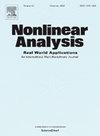Sensitivity analysis of a Signorini-type history-dependent variational inequality
IF 1.8
3区 数学
Q1 MATHEMATICS, APPLIED
引用次数: 0
Abstract
We consider a history-dependent variational inequality which models the frictionless contact between a viscoelastic body and a rigid obstacle covered by a layer of soft material. The inequality is expressed in terms of the displacement field, is governed by the data (related to the applied body forces and surface tractions) and, under appropriate assumptions, it has a unique solution, denoted by . Our aim in this paper is to perform a sensitivity analysis of the inequality , including the study of the regularity of the solution operator . To this end, we start by proving the equivalence of with a fixed point problem, denoted by (Theorem 2). We then consider an associated optimal control problem, for which we present an existence result (Theorem 6). Then, we prove the directional differentiability of the solution operator and show that the directional derivative at in direction is characterized by a history-dependent variational inequality with time-dependent constraints (Theorem 14). Finally, we prove two well-posedness results in the study of Problems and , respectively (Theorem 17), and compare the two well-posedness concepts employed.
signorini型历史相关变分不等式的敏感性分析
我们考虑了一个历史相关的变分不等式P,它模拟了粘弹性体与被一层软材料覆盖的刚性障碍物之间的无摩擦接触。该不等式用位移场表示,由数据f(与所施加的物体力和表面牵引力有关)控制,并且在适当的假设下,它有一个唯一解,用u表示。我们在本文中的目的是对不等式P进行敏感性分析,包括求解算子f≠u的正则性研究。为此,我们首先证明P与一个不动点问题的等价性,用Q表示(定理2)。然后我们考虑一个相关的最优控制问题,我们提出了一个存在性结果(定理6)。然后,我们证明了解算子的方向可微性,并证明了在δf方向上f处的方向导数具有具有时变约束的历史相关变分不等式(定理14)。最后,我们分别证明了问题P和问题Q研究中的两个适定性结果(定理17),并比较了所使用的两个适定性概念。
本文章由计算机程序翻译,如有差异,请以英文原文为准。
求助全文
约1分钟内获得全文
求助全文
来源期刊
CiteScore
3.80
自引率
5.00%
发文量
176
审稿时长
59 days
期刊介绍:
Nonlinear Analysis: Real World Applications welcomes all research articles of the highest quality with special emphasis on applying techniques of nonlinear analysis to model and to treat nonlinear phenomena with which nature confronts us. Coverage of applications includes any branch of science and technology such as solid and fluid mechanics, material science, mathematical biology and chemistry, control theory, and inverse problems.
The aim of Nonlinear Analysis: Real World Applications is to publish articles which are predominantly devoted to employing methods and techniques from analysis, including partial differential equations, functional analysis, dynamical systems and evolution equations, calculus of variations, and bifurcations theory.

 求助内容:
求助内容: 应助结果提醒方式:
应助结果提醒方式:


